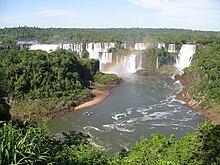Iguaçu
|
Rio Iguaçu Río Iguazú |
||
|
Rio Parana with the Iguaçu as a left tributary |
||
| Data | ||
| location | Brazil ( State of Paraná ), border with Argentina | |
| River system | Río de la Plata | |
| Drain over | Paraná → La Plata → Atlantic | |
| origin | The confluence of the Iraí and Atuba rivers in Curitiba , Cajuru district 25 ° 29 ′ 1 ″ S , 49 ° 11 ′ 23 ″ W |
|
| muzzle | between Foz do Iguaçu and Puerto Iguazú in the Rio Paraná Coordinates: 25 ° 35 ′ 33 ″ S , 54 ° 35 ′ 30 ″ W 25 ° 35 ′ 33 ″ S , 54 ° 35 ′ 30 ″ W
|
|
| length | 1320 km | |
| Left tributaries | Rio Passa-2, Rio Agua Amarela, Rio Negro , Rio Paciencia, Rio Timbo, Rio Pintado, Rio Jangada, Rio Iratizinho, Rio dos Patos, Rio Iratim, Rio Butia, Rio Marrecas, Rio Chopim, Rio Jaracatia, Rio Cotejipe, Rio Capanema, Rio San Antonia | |
| Right tributaries | Rio Verde, Rio Itaqui, Rio de Vargem, Rio da Agua branca, Rio Potinga, Rio Claro, Rio Palmital, Rio da Areia, Rio Cavernoso, Rio das Cobras, Río Guaraní, Rio Adelaide, Rio Tormenta. Rio Concalves Dias, Rio Floriano, Rio Benjammin Constant, Rio Sao Joao | |
| Reservoirs flowed through | Salto Caxias Dam | |
| Big cities | Curitiba , Foz do Iguaçu | |
| Medium-sized cities | Porto União , Puerto Iguazú | |
|
Rio Iguaçu |
||
The Iguaçu (Portuguese Rio Iguaçu [ ʁi.u igwaˈsu ], Spanish Iguazú ( Río Iguazú ) [ ri.o iɣwaˈsu ]) is a 1320 km long river in South America . Its lower course with the famous Iguazú waterfalls is part of two national parks and has also been a UNESCO World Heritage Site since 1984 ( Iguazú National Park , Argentina) and 1986 ( Iguaçu National Park , Brazil) .
Its name is derived from the Guaraní word Yguasu "great water".
course
The entire course of the Iguaçu River runs in or on the edge of the Brazilian state of Paraná . It is created by the confluence of the Iraí and Atuba in the Cajuru district of Curitiba , on the BR-277 highway. At Porto União it forms the border to the Brazilian state of Santa Catarina and flows from there westward through the state of Paraná. During the last kilometers up to its confluence with the Rio Paraná , it is the border river between Brazil and the Argentine province of Misiones .
Near the confluence with the Paraná is the city of Foz do Iguaçu on the Brazilian side and the city of Puerto Iguazú on the Argentine side . The two cities are connected by the Tancredo-Neves Bridge , which spans the river. The river is considered the river of the dead, as the bones of the deceased were thrown into the river, similar to the Ganges, above the waterfalls and disappeared from the view of the bereaved / the mourning community in the "Devil's Throat".
water falls

The river is known for the Iguaçu waterfalls , a few kilometers upstream from the mouth. They are the largest waterfalls in the world by breadth ; the Victoria Falls are taller but narrower; however, its leading edge is uninterrupted. Around three quarters of the cases are on Argentine territory, from where the Tren Ecológico de la Selva can be used to get to the so-called "Devil's Throat", Spanish: Garganta del Diablo . Over the total width of the falls of around 2,700 m, an average of 1,700 m³ / s, after longer periods of precipitation up to 12,742 m³ / s, fall in two stages from 60 m to 82 m, depending on the location. In 1992 it was even 29,000 m³ / s after heavy rainfall.
Álvar Núñez Cabeza de Vaca was the first European to see the falls in 1541 and named them Santa Maria Falls. However, the name he chose could not prevail over the Guaraní word for the cases. Eleanor Roosevelt is said to have only uttered the two words "Poor Niagara!" When looking at these falls. Depending on the interpretation, this can be translated as “poor Niagara Falls” or as “poor / wretched Niagara Falls ”.
See also
Web links
Individual evidence
- ↑ Iguacu River. 2015. Encyclopædia Britannica Online. Retrieved May 9, 2015 from http://www.bridica.com/EBchecked/topic/282415/Iguacu-River
- ^ A b John P. Rafferty: Rivers and Streams . The Rosen Publishing Group, 2001, ISBN 978-1-61530-326-7 , pp. 54-55 ( excerpt (Google) )
- ↑ The Iguaçu River ( Memento of September 4, 2010 in the Internet Archive )
- ↑ Website about the waterfalls and the river system ( Memento from August 11, 2011 in the Internet Archive )
- ↑ Patricia Corrigan, Geoffrey H. Nash: Waterfalls . Infobase Publishing, 2007, ISBN 978-1-4381-0671-7 , pp. 84–86 ( excerpt (Google) )
- ↑ Corrigan / Nash, pp. 92-93
- ^ Todd Lewan: Splashing in waterfalls is a favorite Brazilian pastime . AP Worldstream, October 2, 2002 ( Highbeam ( April 9, 2016 memento in the Internet Archive ))

